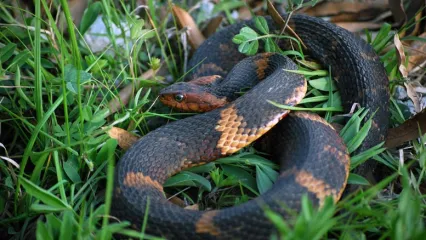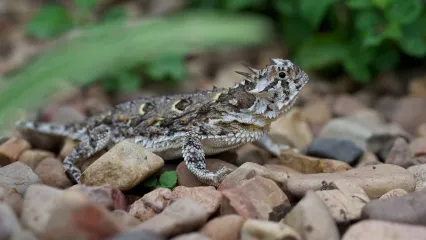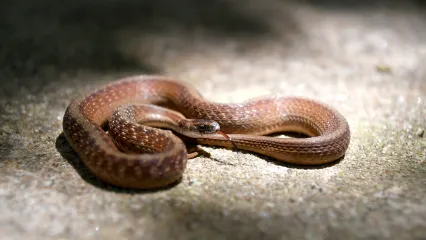
Description
Northern diamond-backed watersnakes are large, heavy bodied snakes that are usually found in, near, or above (on tree branches or shrubs) water. The background color of the body is dark gray to olive or yellow-brown and a series of connected black irregular markings extend the full length of the body in a chain-like pattern. The belly is yellow or off-white and has half moon-shaped brown or black markings along the lateral edges of the belly scutes. Dorsal scales are heavily keeled. The only remotely similar nonvenomous snake is the plain-bellied watersnake which has distinct blotches as a juvenile rather than an chain-like pattern an a yellow belly with no markings. Adult plain-bellied watersnakes are nearly black with no discernible pattern. Both of these watersnakes can be confused with the western cottonmouth, a venomous pit-viper. Plain-bellied watersnakes and northern diamond-backed watersnakes have round pupils in the eyes, divided scales under the tail and lack a pit structure between the eyes and nostril. Western cottonmouths have elliptical pupils in the eyes and complete scales under the tail. All three are aquatic, found in similar places, have heavily keeled scales and are heavy bodied.
Not only are these snakes common in relatively undisturbed habitats, they are common in farm ponds, streams that flow through towns and cities, and all rivers, lakes, and ponds. If anything, these snakes may be more common than they were historically because of the proliferation of ponds associated with development.
Size
Adults vary from about 30-48 inches, but because these snakes are heavy bodied, they appear much larger. Newly born young are 9-13 inches in total length.
Habitat
Northern diamond-backed watersnakes are primarily aquatic but can be found relatively far from obvious bodies of water during heavy rain storms. They live in rivers, streams, ponds, oxbow lakes, lakes, and boggy areas. Similar to plain-bellied watersnakes, they often bask on limbs that overhang water, dropping off into the water when disturbed. In some areas, they overwinter in large numbers inside of beaver dams and can be found basking on the dams in very early spring. In North America, the distribution of northern diamond-backed watersnakes extends from west to east from northeastern Texas to east-central Alabama and north to south from central Illinois well into Mexico.
Life Cycle
Mating occurs in spring and these live-bearing snakes produce young from mid-August through early October. The number of offspring varies with female body size. Small females can produce as few as seven young whereas very large females can produce as many as 48-50 young. Aside from daytime basking, most activity occurs just before dark and at night. Northern diamond-backed watersnakes primarily eat fish, but occasionally take tadpoles (particularly large ones, like bullfrogs), frogs, reptiles, mammals, and some invertebrates (crayfish and insects). Northern diamond-backed watersnakes are harmless to humans.
How To Observe
These conspicuous snakes can be easily observed by walking along shorelines and searching tree branches and shrubs that overhang water. They frequently bask in sun on top of branches, and when approached drop into the water. They can also be easily found in clear rivers and streams by walking just off shore in the water and searching in the water along the bank. If the bank has cavities just under water, these snakes often occupy them. At night, they can be easily found by searching in water with headlights.
(This profile was created by Dr. Laurie Vitt as part of a partnership between the Wildlife Department and the Sam Noble Oklahoma Museum of Natural History. It was funded as part of a larger State Wildlife Grant to survey and inventory amphibians and reptiles of the Wildlife Management Areas of Oklahoma: T-35-P-1.)


